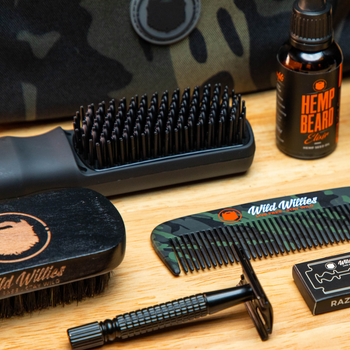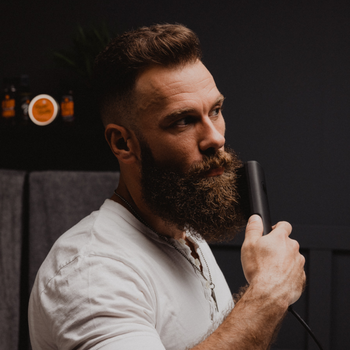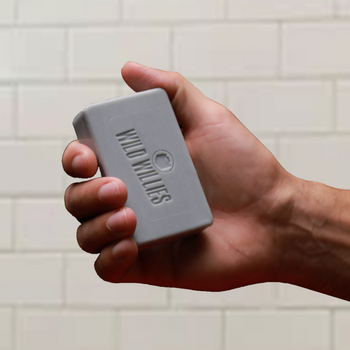No matter what type or length of beard you have, regular maintenance is the key to helping it look, feel, and even smell great. Routine trims are important, but you need the right tools to keep your beard fresh and tamed. When it comes to grooming, shaping, and trimming, you might be torn between an electric shaver vs a razor. Both have their place, but there are advantages and drawbacks to each.
Electric Shaver vs Razor: What's the Difference?
Most shavers and razors can be placed into one of two categories: electric or manual/traditional. Both accomplish the same basic task but in very different ways and, often, with very different results.
Electric Shavers
As the name implies, electric shavers use an electrical current to power a set of blades on the device. These typically move at rapid speeds to slice and dice even coarse beard hair. These days, most shavers are made with rechargeable batteries, but some can still be plugged into an outlet if you forgot to give the tool a decent charging session.
"Electric shaver" is a broad term that covers some very different tools. Which one is right for you? That depends on your beard type and goals.
Rotary
These typically consist of a set of at least three circular heads that spin in different directions. Rotary shavers help pull and lift hairs away from the skin for a close shave. They can be moved in any direction, including circular motions across the face, chin, and neck. These tend to work best for people who prefer a close shave all over.
Foil
These shavers contain a set of parallel blades that move back and forth rapidly to cut facial hair. The blades are covered by sheets of metal, known as foils, that are pierced with tiny holes to allow blades to access the hair follicles but not the skin. Foil shavers must be moved with a straight, back-and-forth motion and can be used to shave around smaller, tighter beards and mustaches. However, you should use them with care to avoid pulling the longer hairs you want to stay intact.
Trimmer
When considering an electric shaver vs a razor, many people forget that trimmers should be included in this group. One of the most versatile types of electric shavers, a trimmer can be used for a variety of shaving needs, from shortening the overall length and cleaning up edges to providing a close shave in smaller areas. Most trimmers come with a variety of guards and attachments, making them true multipurpose tools. Trimmers can be useful for all skin and beard types.
Manual Razors
Traditional razors rely on pure manpower to get the job done. You provide the pressure and motion that results in a close, clean shave. Like electric shavers, manual razors also have a few distinct categories.
Straight
This is the image that comes to mind when you picture a barber in old-timey movies and shows. Straight razors are long and very sharp, and designed to fold in half so the blade is housed safely within the handle when not in use. These razors can provide a very close shave, but they can be difficult to use; great results require a steady hand, the perfect angle, and excellent technique. Otherwise, you could be dealing with a misshapen beard, not to mention unwanted injuries and irritation.
Safety
A major improvement on the traditional straight razor, the safety razor is making a huge comeback in modern-day beard grooming. This cost-effective and environmentally responsible option provides a very close and precise shave. The safety guard helps better protect your skin from nicks and cuts. The entire top portion can be adjusted, removed, and disassembled for easy cleaning, helping the blades last much longer.
Cartridge
The final notable option in the electric shaver vs razor discussion is the disposable or cartridge razor, which has ruled the market for the last decade or so. This type of grooming tool can also provide a pretty close shave, especially with models that contain multiple blades for numerous passes over the skin with just one stroke.
Electric Shaver vs Razor: What are the Benefits?
If you're thinking there can only be one clear winner, think again. Both electric and manual grooming tools can be incredibly useful and may help you achieve the look you want with your facial hair.
Pros of Choosing Electric Shavers
Buying an electric shaver is a one-time cost. There are no refills to purchase on a routine basis, so you don't have to add replacement blades to your monthly budget. In fact, not having to change the blades at all is another advantage. There's no need to worry about removing, installing, or disposing of sharp objects or the negative results of doing so the wrong way.
In general, one of the biggest deciding factors in the electric shaver vs razor debate is the overall time needed. There's no doubt about it: The electric option is fast and easy, much more so than the alternative. With these types of tools, you can shave in a flash, even when you're pressed for time, with relatively dependable results.
When you use electric beard grooming tools, there's no need to use water or shaving cream. While some shavers are waterproof, many models don't need water to perform well. This means you can shave with dry skin, a major timesaving component.
Another notable benefit of using an electric shaver is the significantly lower risk of nicks and cuts. While they are technically still possible, it usually takes some serious misuse to cut your skin while shaving with these tools, especially with a foil option. If you're concerned about cuts and bleeding for health reasons, electric shavers are by far the safer alternative.
Though these tools require electricity, the amount is very minimal. Rechargeable shavers can last about an hour between charges, which translates to several shave sessions before you need to plug them in again. With proper care and use, higher-end products can last for five years or more. When combined with the absence of disposable parts and the ability to use them without water, electric shavers have a relatively low environmental impact overall.
Pros of Choosing Manual Razors
If the pleasure of the process is important to you when comparing an electric shaver vs a razor, the latter is the clear winner. While it does take a bit more care, shaving with a traditional razor can be a very satisfying experience. When you have the time to set aside for it, this method can even be therapeutic and relaxing.
For a super close shave with gratifying results, you just can't top traditional manual razors. Ultra-sharp blades positioned closer to the skin yield smoother results overall. Because the device is smaller and easier to maneuver, regular razors are also more precise, meaning you can shave closer to your beard line or sideburns with confidence and enjoy a cleaner edge.
With the right preparation and technique, razors tend to provide a more comfortable shave with less overall irritation. However, this requires good shaving practices, including:
- Using the proper water temperature
- Applying skin-protecting shave gels or creams
- Shaving in the direction of the hair growth
- Using a clean, sharp blade
- Moisturizing the skin well after shaving
Cost is important when considering an electric shaver vs a razor for your beard grooming needs. Razors are by far the cheapest option and you can get a fantastic product for less than $20 easily. Safety razors are very economical when it comes to both up-front and long-term costs. The razors themselves can last for decades when well cared for.
Traditional manual razors require no electricity at all. Although some disposable and cartridge options lead to unnecessary waste, straight and safety razors are considered environmentally friendly shaving tools. Some products can be sharpened and cleaned for improved longevity. Stainless steel blades are even recyclable, although you will need to follow your local area's regulations.
Electric Shaver vs Razor: What are the Drawbacks?
Nothing in life is perfect, and the same is true of beard grooming tools. Even the very best options can have a few downsides.
Cons of Using Electric Shavers
Perhaps the biggest argument against picking an electric shaver is the cost. Even low-end options will cost you more than most high-quality razors. However, if you want better results, you'll probably want to invest in a nicer product, which can run you close to $400 or more.
While regular razors can make a mess in your sink, electric shavers can make a mess across your entire bathroom. Rotary razors have a tendency to send those trimmed hairs flying across the counter and all over the room. Unfortunately, you might not have much to show for all that cleanup; many people agree that even the best electric shavers just don't provide a smooth, close shave.
Comfort matters when you're shaving and in the electric shaver vs razor competition, electric comes up short. These tools have a tendency to pull those sensitive facial hairs, leading to irritation and discomfort. Because they encourage you to shave against the grain, they can also lead to more ingrown hairs.
Electric shavers must be recharged eventually. If you forget to plug them in on time, you're out of luck for at least one to two hours. Some models can also be difficult to clean, especially if they aren't waterproof, and can develop a buildup of hair, skin cells, and oil over time.
With the exception of some trimmers, electric shavers overall are not ideal for most bearded dudes, especially if you like to keep things longer than an inch or so. Their lack of precision can ruin your look in an instant while irritating your skin.
Cons of Using Manual Razors
What's the biggest drawback of using a manual razor to shape your beard and smooth out your skin? The blades are sharp and not too well protected, so even careful, experienced shavers can nick and cut their skin with relative ease. It takes a lot of practice, patience, and skill to learn how to shave properly, especially when switching to a new product.
Even if you are very comfortable with your current razor, it can still take a long time for a basic shave, and even more so when you're shaping your beard. The process is also a messy one that requires water, shaving cream, and at least a few minutes of clean-up if you don't want to get yelled at by your partner.
When comparing an electric shaver vs a razor, the long-term costs of a razor are higher, as you'll need to replace the blades routinely to ensure a close shave. Depending on your hair and skin type, this could be quite frequent, as replaceable blades tend to dull relatively quickly. You should clean and dry your razor every time you use it to prolong blade life, but this can add to an already time-consuming process.
If you use a disposable or cartridge razor, the costs are quite high when you consider how often the refills should be replaced. In addition, these products are not environmentally friendly. Because the plastic and metal components cannot be separated, the cartridges are not recyclable. If you shave with running water (as opposed to filling the sink with water and reusing it as you go), the energy use can be high, especially if you use your razor on a daily basis. In these situations, disposable and cartridge razors can have a negative impact on the environment and on your water bill.
Electric Shaver vs Razor: The Wild Willies Way
When it comes to beard upkeep, a good arsenal of tools is often the best approach. If you're torn between an electric shaver vs a razor, instead of going all or nothing, know the right time to use each one for clean, precise results and calm, comfortable skin. If you want to find the best tools for every beard length, be sure to check out all of the products Wild Willies has to offer. Our tools and grooming kits give you everything need for a killer style from start to finish.






